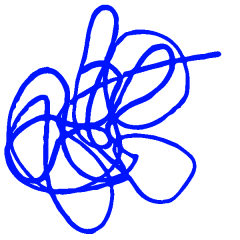I came across the Arecibo message years ago and was always quite fascinated by the format and the content of it. The idea of creating a message directed towards a potential audience without having any indications of how the audience is like is very interesting to me. Trying to create a message using limited methods like the binary code, plus considering the importance of the content is very challenging. This raises the question of why the attempt to contact alien life was boiled down to one universal message that also was broadcasted into space just once. The chances of anyone paying attention to that specific direction in space and at that specific time are very low. With this project, my aim is to challenge the universal approach of sending one single important message into space. I want to focus on individuality over universality. Inspired by the Monday lecture from the 10.May.2021 by Studio Safar I want to use the medium of the Arecibo message to analyse and visualise messages, voices, or data that are underrepresented. I’m not sure yet how to filter out and decide which topics I want to include but first I want to focus on dissecting the initial message and get a better understanding of the content, the hierarchy, the different kinds of information included, the way it is encrypted and the format of the message.
After analysing the message I decided to go forward and ask people about what objects/information they would send out into space. Then, it was time to learn how to use binary code in order to encrypt numbers and letters in the message. I wanted to focus on using the original format and system to investigate the simplifying of the content, especially of the image-based content. How much is lost and what is gained from creating „poor images“? Also, how does the encryption, transmission, decryption and interpretation of these pixel images influence the content originally conveyed?
For me the content has always been very important and something that took me a really long time to decide on. Although Carls Sagan and Frank Drake (the creators of the Arecibo message) themselves said that the content doesn’t matter it kind of still mattered to me (Overbye, 2020). It made me think about how it is very common on Social Media to post, share and save images without even considering or thinking about the importance and also origin of the content. We are shraring images and posting things that soemtimes weren’t created to communicate anything. No second thought. Just and image shared for the sake of being shared and seen for the sake of being spoonfed empty content. If we send empty messages have we decided to communicate with an unkown or non-existing/not yet existing audience? Are we trying to find the audience that would interpret the message in a way that suits us? Empty content seems like fish bait attracting any kind of attention you can get and valuing all of it.
For my visual essay I had two different approaches in mind. I thought about an 70s/80s inspired „How to“ video which would also be a hommage to the decade the Arecibo originated from and it would introduce the complex content into a interesting format. Carl Sagan was very well known for being a master in explaining difficult and complex content in a way to make it accessable for everyone outside the field of astophysics.
My project is very complex and would suffer from being condensed too much but the structure of the „How to“ Video would certainly help in conveying the content.
Although I’m trying to make my project understandable for the essay viewer I’m very hesitant in condensing all of the information and journey. The process is the outcome and it needs to be presented appropriately otherwise the project would suffer from information loss.
Benjamin Bratton said in his TED Talk “New Perspectives – What is wrong with TED Talks” that problems are complex and difficult and can’t just be resolved in an instance by just rearranging existing pieces. Making everything simple, condensed and boiled down so that it can be “swallowed without chewing” (Bratton, 2013) doesn’t challenge transformation and innovation. Complexity over simplicity.
Overbye, Dennis: A Rip in the Fabric of Interstellar Dreams, The New York Times, Aug. 21, 2020
Bratton, Benjamin: What’s Wrong with TED Talks?’, TEDxSanDiego, https://www.youtube.com/watch?v=Yo5cKRmJaf0 ,2013
Also, after already deciding on the “How to Video” for the visual essay I was still really inspired by :
Steyerl, Hito: How not to be seen a fucking didactic educational mov. File; 2013, https://www.artforum.com/video/hito-steyerl-how-not-to-be-seen-a-fucking-didactic-educational-mov-file-2013-51651, 25.05.2021
